
In this lesson, we’ll present some musically cool and useful ways to play and apply diatonic (scale-based) intervals, specifically thirds and sixths, all over the fretboard, offer some exercises, discuss applications, and provide “real world” examples of these shapes in play.
When it comes to harmony, these dynamic duos are the sweetest sounding of them all, and for that reason they’re a mainstay in the arsenal of experienced pickers. They really are must-know shapes for electric guitar and acoustic guitar players alike.
C Major Scale in Thirds
We’ll get started with some basic music theory, harmonizing the major scale in what are called diatonic (scale-based) thirds. For this lesson, we’ll focus on the C major scale: C (root), D (2), E (3), F (4), G (5), A (6), B (7), C (octave root).
Start with the root (C) and count up two scale degrees (“1, 2, 3”) to arrive at E. C and E played together form a dyad, and more specifically a major third interval, (spanning the distance of two whole steps).
To harmonize the second degree of the scale (D), count up two scale degrees from that note to arrive at F. D and F together create a minor third interval (which is only one and one-half steps). And so it continues on up the line through the remainder of the scale, with various major and minor thirds. But before we go any further, let’s apply this process to the guitar.
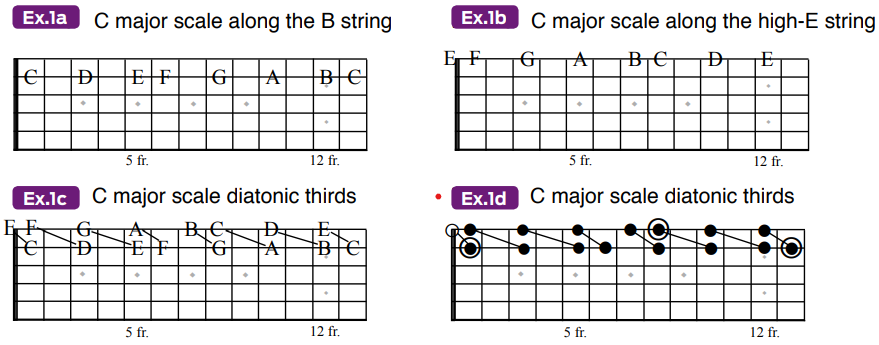
Ex. 1a voices the notes of the C major scale along the B string. Ex. 1b places the notes of the scale along the high-E string, but starting from the third degree of the scale, E. Ex. 1c pairs the notes on the two strings together, starting with C on the lower string and E on the higher string (E/C, as in “E over C”) followed by D on the lower string and F above it (F/D); the process continues on up the fretboard.
The end result is a set of two-note chords, or dyads, harmonized from the same scale. You’ll want to memorize the quality of each interval: E/C = major third; F/D = minor third; G/E = minor third; A/F = major third; B/G = major third; C/A = minor third; and D/B = minor third. The resulting formula of thirds is “major minor minor major major minor minor.”
All the latest guitar news, interviews, lessons, reviews, deals and more, direct to your inbox!
The diagram in Ex. 1d uses a system of dots and joining lines to illustrate the dyad “shapes.” The circled dots mark the “tonic” (root) notes, C. Try to memorize the visual and physical pattern of the shapes. The major thirds are spaced one fret apart, while the minor thirds are spaced two frets apart, and they all follow a specific sequence. If you memorize the pattern, you can transpose the entire lineup to different keys on your own. For example, move everything up two frets to play diatonic thirds in D major.

The next set of examples offers fret-hand fingering suggestions for the intervals. Ex. 2a shows these dyads played as chords, in ascending form. (Thirds and other intervals played as chords are often referred to as harmonic intervals.)
Ex. 2b illustrates melodic thirds, where the intervals are “arpeggiated,” or played one note at a time. You’ll notice the fingering suggestions are somewhat different in each example. Ex. 2a offers consistency by keeping the third finger assigned to the B string, while Ex. 2b uses the first finger to fret the high-E string notes. Fret-hand fingering choices often vary, depending upon what follows or precedes the interval shape being played. It’s optimal to practice all fingering possibilities and combinations.
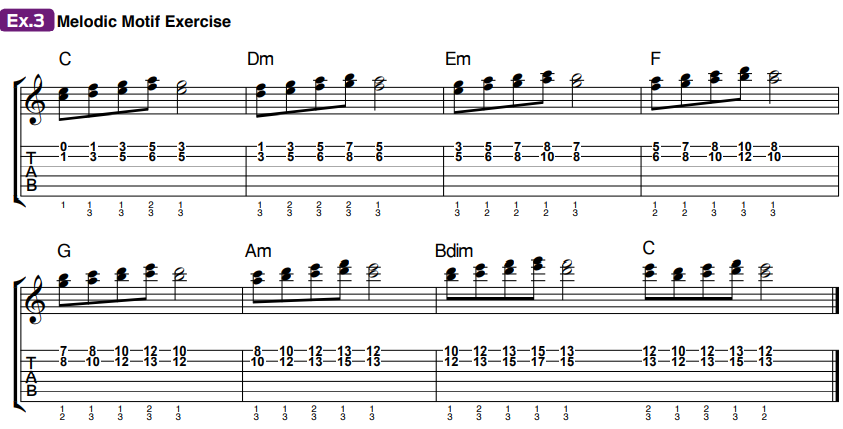
Ex. 3 is a melodic motif (short musical pattern) exercise that discloses the considerable harmonic potential of strategically placed thirds. Bar 1 establishes the pattern: four ascending dyads and back one to resolution.
Note the beginning and resolving intervals: E/C and G/E. Both dyads are made up of notes that are part of a C major triad (C E G). The next measure compliments a Dm triad (D F A), beginning and ending on dyads made up of notes that are included in that triad. (These starting and stopping places provide a firm, “home base” tonality for the corresponding chords.)
As you play through the example, have a friend play the chords on guitar or keyboard. Incidentally, each bar exhibits the tonal aspects of each mode of the C major scale: D Dorian (D E F G A B C), E Phrygian (E F G A B C D), F Lydian (F G A B C D E), G Mixolydian (G A B C D E F), A Aeolian (A B C D E F G) and B Locrian (B C D E F G A).
Some of these modal possibilities will be explored in subsequent examples.
Thirds on the Remaining String Sets
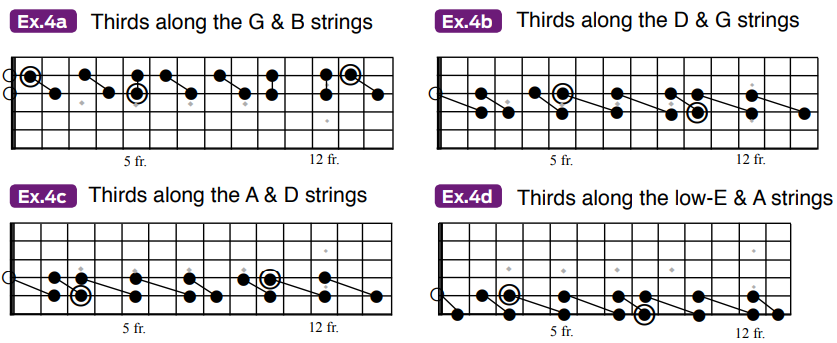
The neck diagrams in Examples 4a–d illustrate the thirds shapes along the remaining pairs of adjacent strings. Upon close inspection, we see that they all follow the same physical and visual pattern we examined earlier on the B and high-E strings, with the exception of the G and B strings, for which the shapes are different. This is due to those strings being tuned a major third apart instead of a perfect fourth.
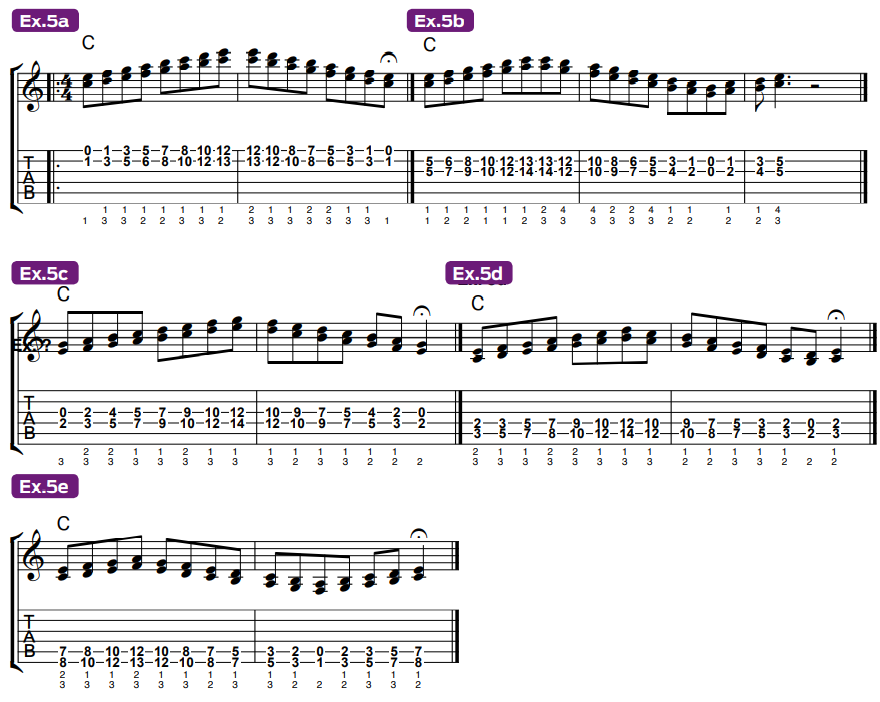
Use the exercises in Examples 5a–e to “burn in” these shapes. Notice that all the examples start in the “home base” interval of E/C (see above).

Ex. 6a–e is a melodic-motif exercise inspired by the intro riff to Van Morrison’s “Brown Eyed Girl.” Spend some time running through the figures. It will help you get the feel of where home base (E/C) lies on each set of strings.

Ex. 7a takes the motif from the previous example but starts from the other home base interval (G/E) that corresponds to the C chord harmony. Ex. 7b flips the motif around in descending fashion.
Riffs with Thirds

Now let’s look at a few ways to create musically pleasing riffs that utilize some of the shapes we just learned. Ex. 8 is inspired by a descending figure George Harrison played in the Beatles song “With a Little Help From My Friends.” Harmonized from the C major scale, it sends thirds down the G and B strings (see Ex. 4a), fortified by a ringing, open high-E string, which is used as a common tone.
Notice how the line nails the changes, starting with the home-base interval G/E on the C chord, and resolving to a home-base interval of D/B over the G chord. The open high-E string provides extra color and sparkle.
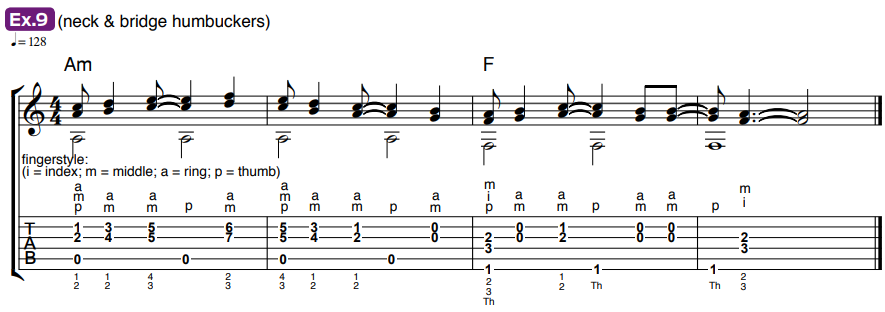
Ex. 9 is in the fashion of super-picker Lindsey Buckingham’s riffing in Fleetwood Mac’s “Rhiannon.” Drawing from the relative A natural minor scale (A B C D E F G), it casts diatonic thirds along the G-B and D-G string sets (see Examples 4a and 4b).
This passage is performed fingerstyle; use your thumb to play the bass line (the notes on the A and low E strings), and your middle and ring fingers to pick the dyads on the G and B strings. Try using your index and middle fingers to pick the dyads that fall on the D and G strings.

Ex. 10 intersperses several string sets (see Examples 4a-c) in a bluesy phrase that sits well over a G7 chord. Based on the G Mixolydian mode (G A B C D E F), it has a cool R&B flavor and is similar to something Larry Carlton or John Mayer might play.

Ex. 11 is a hot country lick, comparable to what Brent Mason or Brad Paisley might toss into a burning solo. Also based on the G Mixolydian mode, this example features a series of thirds played on the G and B strings, each of which are pulled off to produce an open B/G dyad, which is quickly answered by a lone open G note.
Hybrid picking (pick-and-fingers technique) is essential for this example. The diatonic dyads in this lick are embellished with chromatic insertions (Bb/Gb, Gb/Eb and Db/Bb), which are standard fare in a lot of bluegrass and modern country solos.
Sixth Intervals
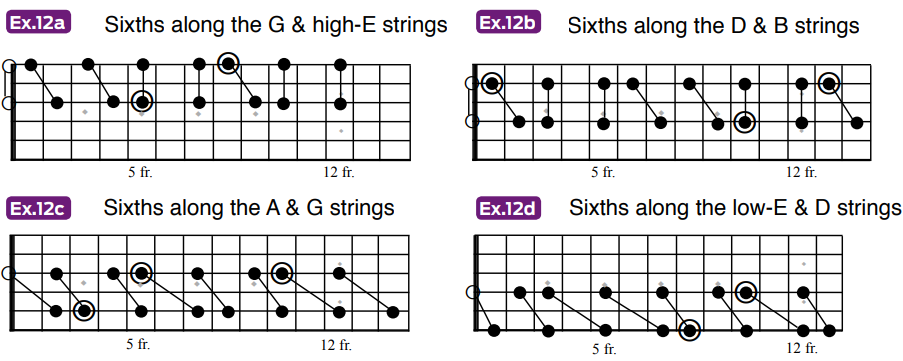
Sixth intervals are created by pairing notes that are five scale steps apart. For example, to create a sixth interval above C, count up five scale steps (D, E, F, G, A) to arrive at A. The resulting dyad is A/C (A over C).
Likewise, you can also count down five scale steps from C to create a sixth interval (B, A, G, F, E). This results in a C/E dyad. Sixth intervals are like inverted (as in “upside down”) thirds. E above C is a third, while E below C is a sixth. The diagrams in Examples. 12a–d illustrate sixth intervals harmonized from the C major scale. Notice that all the shapes are voiced on nonadjacent string sets with an unused “dummy” string in between. Unless specifically desired, these “inner” strings are not to be played and need to be muted. (Note: While it is possible to play sixth intervals on adjacent string sets, the more compact shapes shown here are far more common and often more practical.)
Sixths Exercises and Muting Techniques
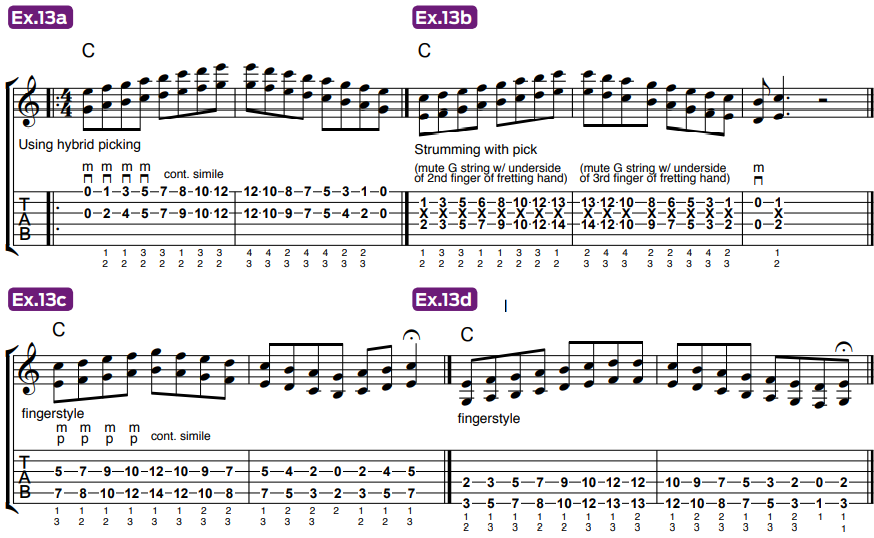
The aim of the next set of exercises (Examples 13a–d) is threefold: 1) To give you a set of suggested fingerings; 2) to provide examples of picking and muting techniques; and 3) to illustrate where the home base intervals are located.
Let’s first address the latter point. We’ve witnessed that, with thirds, the home base intervals are where the root or third of the chord is voiced as the lower note of the dyad. With sixth intervals the root or third should be voiced as the top note. With that in mind, these examples begin and end on the lowest (down toward the headstock) possible home-base interval that implies a C chord tonality.
Ex. 13a voices the sixths up the G and high-E strings. This passage should be performed with hybrid picking.
Ex. 13b demonstrates a standard strumming approach where it’s necessary to mute the inner string, in this case the G string. Best results occur when the fleshy underside of the finger that frets the D-string notes is used to mute the G string.
Examples 13c and 13d both employ fingerstyle techniques, where the thumb down-picks the lower string while the middle finger up-picks the higher string.

Ex. 14 is a muting exercise that features a funky rhythm pattern similar to one Steve Cropper played in “Soul Man” by Sam and Dave. The pattern is established in bar 1 on the G and high-E string, then gradually moves to lower string sets.
Use this example to develop your fret-hand muting techniques. In the first two bars, use the fleshy underside of your second finger to mute the “dummy” string. Mute with the underside of your third finger in measures 3 and 4.
Sixths Licks and Phrases

Ex. 15 is similar to Richie Sambora’s haunting intro riff in Bon Jovi’s “Wanted Dead or Alive.” Cast against a Dm chord, the passage is based on the Dorian mode (D E F G A B C). This is a prime example of using melodic intervals to create a harmonic-interval texture. (Letting the notes ring together gives the aural illusion of two-note chords).

Ex. 16 is a ’50s-style “rock and roll” passage reminiscent of Jimmy Page’s riffing in Led Zeppelin’s “D’yer Mak’er.” Notice how each set of intervals compliments the tonality of its corresponding chord change. Essentially, every lick begins and ends on solid home-base territory in regard to the corresponding chord tones.

Ex. 17 is a blues turnaround phrase, custom made for the last two measures of a 12-bar blues in C. Based on sixth intervals in the key of C major, the lick incorporates two chromatic embellishments (Eb/Gb in bar 1 and an isolated Eb note in bar 2) used to connect the ensuing dyads.
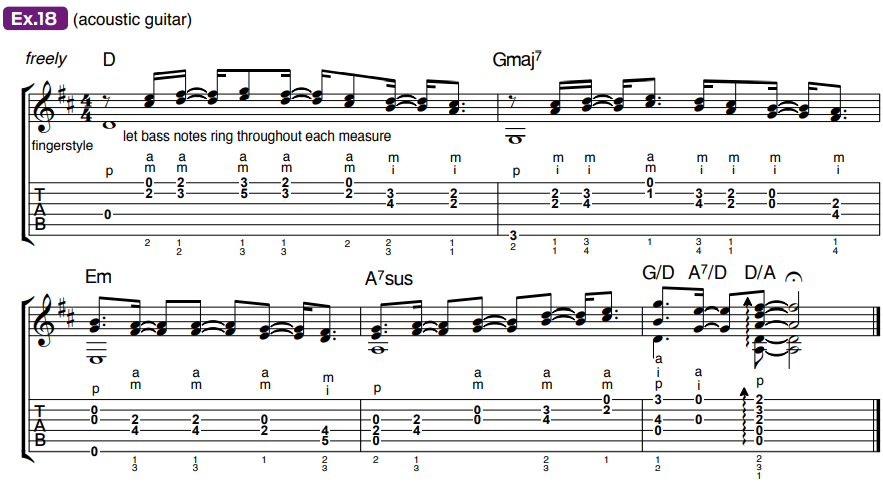
Ex. 18 is a chord melody arrangement that exhibits the melodic potential of thirds and sixths. Based on the song “Dance with Me,” an acoustic-pop hit from the Seventies by the New York rock band Orleans, it relies exclusively on diatonic thirds and sixths harmonized from the D major scale, and reinforced with sustained low notes to anchor the chord tonalities.
